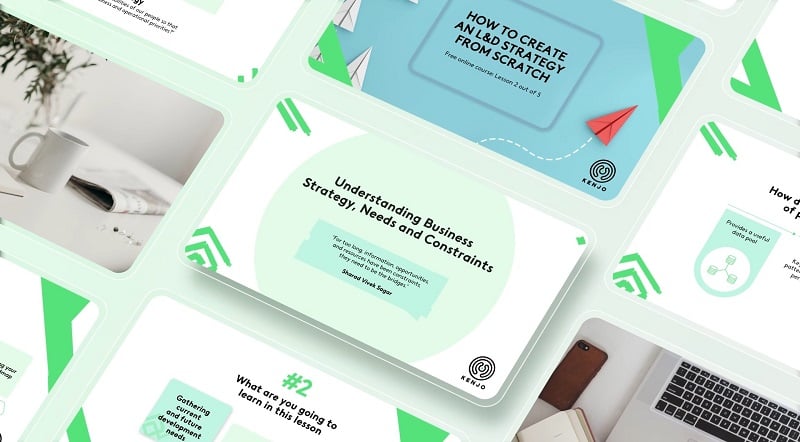Business Strategy, Needs and Constraints of an L&D Strategy — Lesson 2
Getting started
|
|
|
Part IReview existing Needs |
Part IIPrioritising and Constraints |
|
Here, you'll learn how to analyse your current and future development needs within your organisation. |
We show you how to prioritise the most important and impactful needs and how to factor in constraints and resource needs. |
|
|
|
 |
 |
Part IIINeeds Analysis templates |
Part IVDownload session guide |
|
Download our powerfully designed step by step guides to get started with your Needs Analysis. |
In order to better follow these videos, please download this presentation and have a read through. |
|
|
|
Part I
Review existing Needs
Watch the first part of our online video course to understand how to analyse current and future development needs within your organisation.
Part II
Prioritsing and Constraints
Then in part 2, using these development needs that you have just identified, we’ll teach you how to prioritise the most important and impactful ones. Finally, we’ll talk about the all too pragmatic concern of how to factor in constraints and resource needs.
Part III
Needs analysis templates
Download your Needs Analysis template #1
After watching both part 1 and part 2 of the videos, we highly encourage you to take action to complete the post lesson activities. Download the step by step guided templates to help you with them. The goal of the needs analysis is to gather information on what your organisation’s current and future development needs are.
 Needs Analysis with Multiple Stakeholders - Why do it?
Needs Analysis with Multiple Stakeholders - Why do it?
Whilst you and your team can gather a lot of data on your own from performance or survey data, the perspective of business leaders responsible for driving the success of the business is invaluable.
Doing the needs analysis interviews also allows you to act proactively as a partner to the business by preemptively planning for their development needs as opposed to receiving training requests from the business when needed.
Download your Critical Gap and Prioritisation Analysis
template #2
This facilitation guide is meant to help you facilitate a prioritisation exercise with your Power Team (check out lesson 1 if the term Power Team is unfamiliar to you).
Critical Gap and Prioritisation Analysis - Why do it?
The goal of the prioritisation exercise would be to align your key stakeholders on the learning priorities for the organisation. The exercise will also create space for your key stakeholders to have important discussions around the organisation’s learning needs.
As you can imagine, stakeholders across the business areas will have different ideas on what the key learning priorities should be. Therefore, a great way to align the different opinions and get stakeholder buy-in is to facilitate a discussion amongst all of them.
![]()
Download your Needs Analysis templates here

|

|
|
|
![]()
Part IV
Download the session guide
In order to better follow Alison in this video, please download this presentation here and have a read through when you have a moment.
When you are done with these activities, see you in lesson 3!
Learn from the best — Our L&D experts
 |
 |
 |
|
Eveli Marconatto L&D Manager
Netflix |
Vilmalotta Ala-Tuuhonen Senior People Development Specialist Blinkist |
Aki Friedrich People Development & Learning Partner Taxfix |
 |
 |
 |
|
Dinye Hernanda Senior Learning & Development Manager |
Héléne Bejjani Global Learning & Development Leader |
Lavinia Mehedintu People Experience Manager eMAG |
Turn your company into a learning powerhouse
A study by Capgemini found that 47% of employees would move to another employer that provides better digital skill development. The market is and will continue to evolve. So, whether it’s information on the future skills needed to drive long term business strategy, or as an employee attraction and retention strategy, it’s important to factor future labour market trends in your L&D strategy.
So in order to gain insight into how to construct an L&D budget, the most vital steps are
1. Gathering current and future development needs
2. Prioritising and addressing critical gaps
3. Taking resources and constraints into account
In this context, learning gaps refer to the development needs that are not addressed by an existing solution or intervention. You can discover these gaps by comparing them against the learning audit that you did in lesson 1 Post lesson activity B. Any knowledge, skills and abilities (KSA) and corresponding target employee group not served by an existing solution identified in your learning audit would be a learning gap.
Competencies can also be really useful in your future oriented L&D strategy. Having a set of core competencies for leadership or the organisation will provide a big picture view of the KSAs needed for the success of the organisation. Core competencies also provide a benchmark which enables employees to self-assess their learning needs and drive their own development!
Try Kenjo's performance management feature during a 14 day trial and see how it enhances your employee competencies.
Who developed the course?
 Alison JY Lee
Alison JY Lee
As a leadership coach and organisational psychologist, Alison is on a mission to create meaningful, vulnerable and courage-filled workplaces. She is a long-term partner of Kenjo and works closely with our team to help people thrive, and companies truly succeed.
![]()
Kenjo is here to support HR teams to become a strategic partner within their company, helping people to reach their potential, and the company to truly thrive.
Sources
What’s coming next?
Lesson 3 will walk you through identifying your key priorities and how to create measurable goals to check if you are keeping on track.
Would you like to learn more about learning and development from Alison? With Kenjo’s free Performance Management eBook, you'll to design a performance management system that actually improves the performance of your employees.
Get to know Kenjo’s solution to increase employee satisfaction here.


